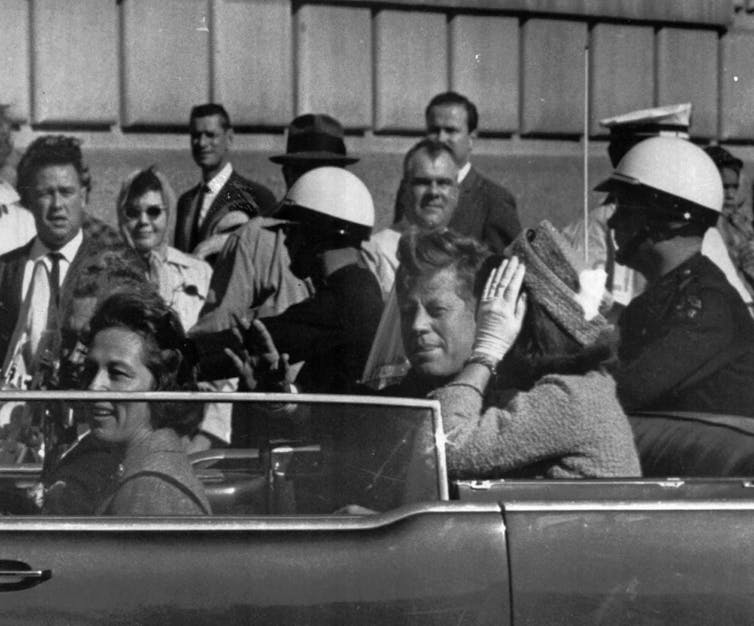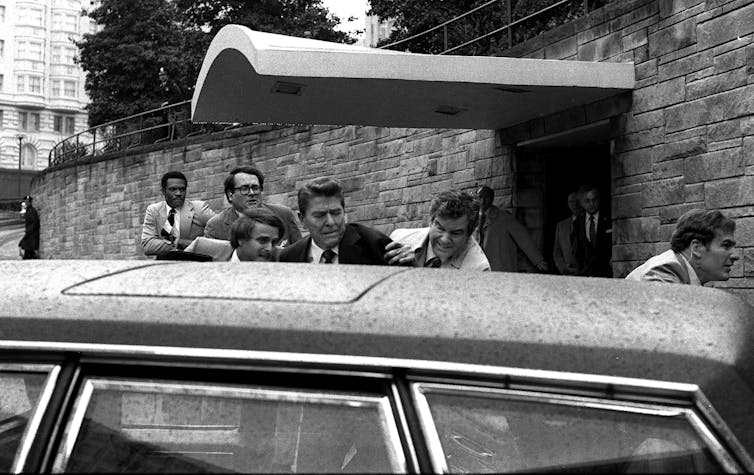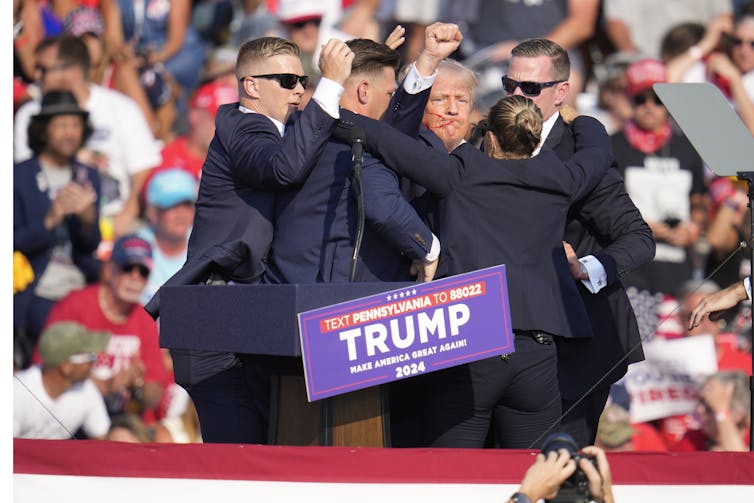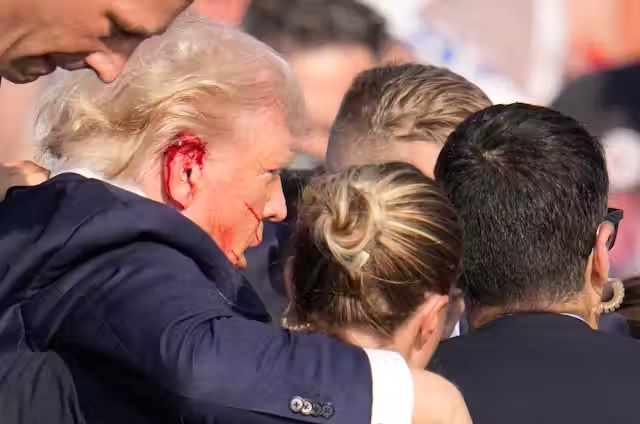Republican presidential candidate and former president Donald Trump is surrounded by U.S. Secret Service agents as he is escorted off the stage during a campaign rally in Butler, Pennsylvania, on Saturday. (AP Photo/Jean J. Puskar)
Thomas Klassen (York University, Canada)
Political assassinations in the United States have a long and disturbing history.
The assassination attempt on Donald Trump on Saturday, in which a bullet grazed his right ear while he was speaking at a campaign rally in Pennsylvania, highlights the dangers of those seeking votes in a country whose constitution guarantees people the right to bear arms.
Trump joins a not-so-exclusive group of U.S. presidents, former presidents and presidential candidates who have been the target of a bullet: Of the 45 people who have served as president, four have been assassinated while in office.
Given the almost mythical status of the U.S. president and the nation’s role as a superpower, political assassinations strike at the very core of the American psyche.

In this photo taken on Nov. 22, 1963, President John F. Kennedy rides in a motorcade with his wife, Jacqueline, shortly before he was shot and killed in Dallas, Texas. (AP Photo, File)
The assassinations of Abraham Lincoln in 1865 and John F. Kennedy in 1963 are key moments in U.S. history. James Garfield (1881) and William McKinley (1901) are less well remembered, but their deaths nevertheless shook the nation at the time.

A life-size painting of President Abraham Lincoln, the first U.S. president to be killed by an assassin’s bullet. (AP Photo/Carolyn Custer)
Secret Service provides security
After the assassination of President McKinley, the United States Secret Service was given the task of providing full-time guardianship to the President.
The last US president to be shot was Ronald Reagan, who was seriously injured in 1981 and required emergency surgery.
As President Reagan was leaving a Washington hotel after delivering a speech, gunman John Hinckley Jr. fired a .22 caliber pistol at him. One of the bullets ricocheted off the president’s car and struck him under his left armpit. President Reagan was hospitalized for 12 days before returning to the White House.

In this March 30, 1981 photo, President Ronald Reagan, center, is shoved into the presidential limousine by Secret Service agents after he was shot outside a Washington hotel. (Associated Press/Ron Edmonds, File)
The other president was also shot, but fortunately no one was injured.
In 1933, a gunman fired five shots into the car of then-President-elect Franklin D. Roosevelt. Roosevelt was spared, but Chicago Mayor Anton Cermak, who was speaking with Roosevelt after the new president delivered a short address to the nation, was wounded and died 19 days later.
Two attempts in one month
In September 1975, President Gerald Ford survived two assassination attempts, both perpetrated by women. The first occurred on September 5, when Lynette (Squeaky) Fromm, a follower of cult leader Charles Manson, attempted to shoot President Ford as he was walking through a park in Sacramento, California, but her gun misfired. On September 22, Sarah Jane Moore, a woman with ties to left-wing extremist groups, fired one shot at President Ford as he was leaving a hotel in San Francisco, but missed him.
Presidential candidates have not been immune to assassination attempts, most notably the 1968 assassination of Senator Robert F. Kennedy and the 1972 shooting of George Wallace, who was left paralyzed from the waist down.
In 1912, former President Theodore Roosevelt was shot in the chest by a .38 caliber bullet while campaigning to retake the White House. However, most of the impact of the bullet was absorbed by something in Roosevelt’s breast pocket. Despite being hit by the bullet, Roosevelt continued his campaign speech with the bullet still lodged in his chest.
Violence in 1968
Other unelected but significant political figures have also been killed by gunfire, most famously the Rev. Martin Luther King Jr., in 1968, just months before Bobby Kennedy’s death.
In a country where there are more guns than people and firearms are readily available, it is not surprising that shooting has always been the method of choice for killing or attempting to kill those in political office.
As in Trump’s case, most assassination attempts occur when candidates or politicians are in public places with large crowds. There is a long history of politicians insisting on “contact” in response to security threats, against the advice of their national security advisers. Trump was extremely lucky to escape with only minor injuries.

Republican presidential candidate and former president Donald Trump is escorted off stage during a campaign event in Butler, Pennsylvania, Saturday, July 13, 2024. (AP Photo/Jean J. Puskar)
Thomas Klassen, Professor, School of Public Policy and Administration, York University, Canada
This article is republished from The Conversation under a Creative Commons license. Read the original article.


